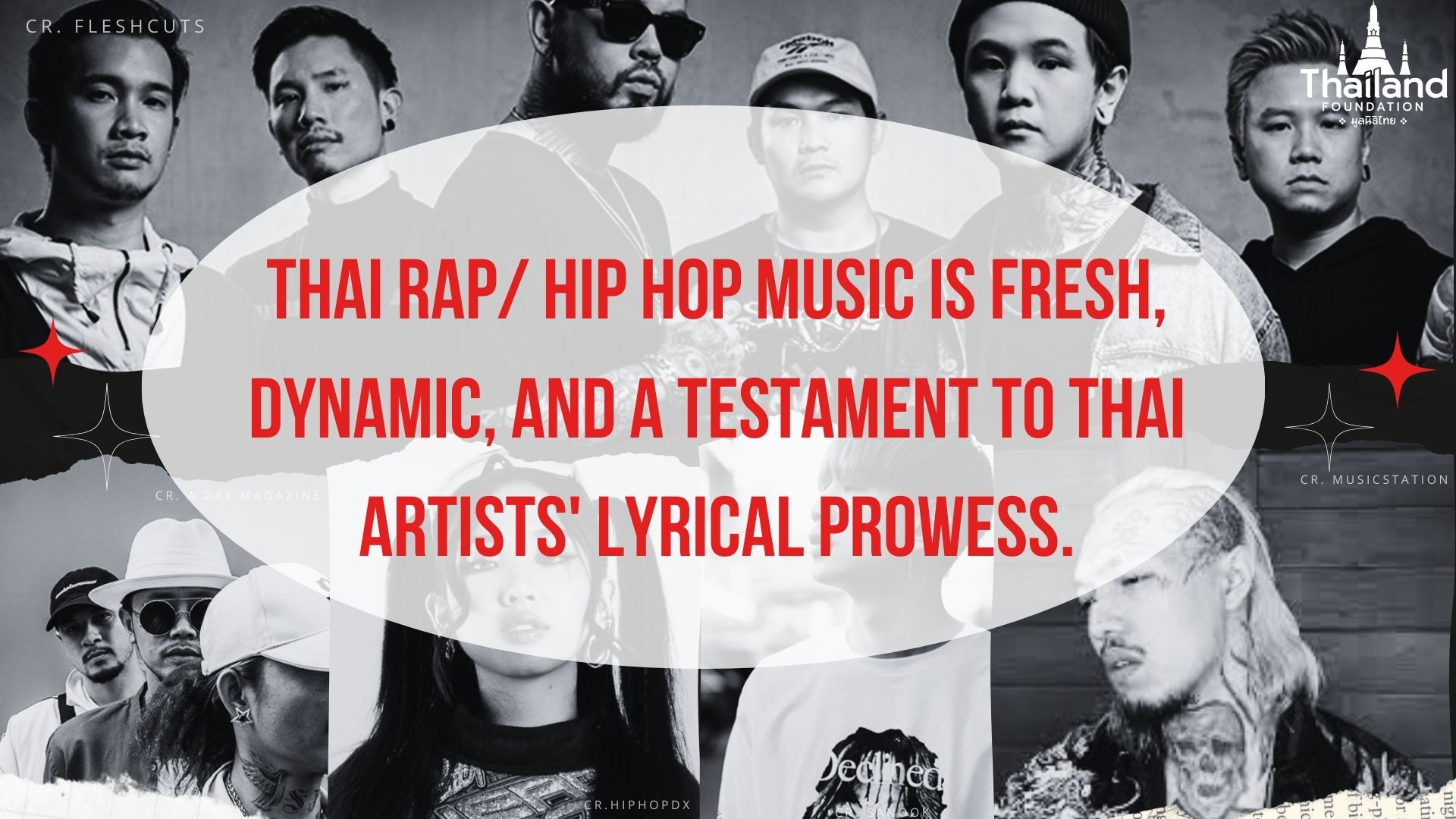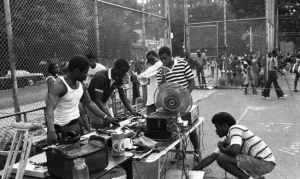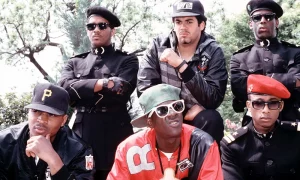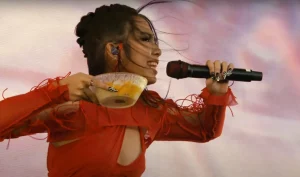Rap/ Hip Hop Music in Thailand

If revolution is one of the powers that music possesses, there is no doubt that rap and hip-hop were the genres that sparked influential cultural phenomena across the world. Hip-hop is a musical genre that embodies versatility. Its diverse perspectives, intricate wordplay, and the remarkable ability to vividly narrate stories serve as a mirror, reflecting the characters and experiences of the real world, and transforming them into powerful musical expressions.
As hip-hop crosses borders, it takes on diverse forms. How Thai hip-hop differs from the West is a compelling question. Beyond language, traditional instruments and culture enrich Thai hip-hop, making it unique. This Exploration unravels threads that reflect its culture and global impact.
What is Rap Music?
The origins of rap music dates back to African and African-American traditions, but has since evolved into a global phenomenon with diverse styles and subgenres. The lyrics in rap music carry strong and powerful meanings, often serving as a means for artists to reflect on the cultural and social landscapes of their origins. Many people are familiar with the concept of rhyme when it comes to rap, as it typically features rhythmic delivery accompanied by a strong and dynamic beat or instrumental track. It can also be referred to as hip-hop music, a genre that is highly distinctive, allowing rappers to freely experiment with their choice of words, poetic techniques, storytelling, and lyrical prowess.
Hip-hop originated in the early 1970s in the Bronx, New York, a period marked by the prevalence of poverty and violence within Black communities. During this time, conversations about race and racism in America were deemed sensitive topics. It was within this context that rap and hip-hop music took on a crucial role in mirroring the challenges faced by these communities. Through music, these narratives resonate with a broader audience, reaching more individuals. Rap music, in particular, has consistently proven to be a potent instrument for confronting and expressing opposition to adverse aspects of life.

Cr. iconcollective.edu
Numerous artists leverage their musical abilities to champion peace and denounce acts of violence. Originating in the U.S. old school period, hip hop has globally permeated every corner of the earth. In the early 1980s, its dissemination was accelerated by iconic movies like Wild Style, Beat Street, and the final segment of Flashdance. International tours, featuring U.S. rap artists like Public Enemy, further fueled hip hop’s global influence.

Public Enemy, the U.S. rap artists
Cr. udiscovermusic.com
As hip hop reached diverse cultures, it adapted to local identities, infusing lyrical content with locally significant issues. Initially serving as a medium for social and political commentary, rap later branched into more mainstream and commercial sub-genres.
Widespread recognition owes much to increased media exposure, particularly through television, movies, and commercials. Technological advancements heightened visibility and accessibility, turning rap and hip-hop into powerful tools for expressing delicate issues. This allowed artists to share authentic experiences, adding depth and authenticity to the genre. The genre’s relevance attracted listeners seeking impactful messages, transcending language boundaries and connecting people globally.
History of Rap/ Hip Hop Music in Thailand
Rap and hip-hop music made their entrance into the Thai music industry during the vibrant period spanning from 1977 to 1987. This era witnessed the emergence of several small music labels, including Nithithat Promotions and Keeta Records. Early Thai rap songs from this time were characterized by clever wordplay, rhyme schemes, and expressions that fostered strong connections between the lyrics and the audience. An example includes the track “Mun plaek dee na” (มันแปลกดีนะ) by Rewat Puttinan (1986).
“Mun plaek dee na” (มันแปลกดีนะ) by Rewat Puttinan (1986)
The period from 1991 to 1995 saw the emergence of hip-hop into the mainstream music scene in Thailand. Key figures in this transformation included Jetrin Wattanasin (เจตริน วรรธนะสิน) of GMM Grammy, who established J-E-B (จ เ-ะ-บ) in 1991, Touch Na TakuaThung (ทัช ณ ตะกั่วทุ่ง) from RS, who introduced the Touch Thunder set (ชุดทัช ธันเดอร์) in 1991, and the TKO band from Kita Records, contributing to the ORIGINAL THAI RAP set in 1993. Notably, Joey Boy, initially affiliated with the Bakery Music label, embarked on his solo hip-hop career in 1995, marking a significant turning point. During this era, there was a surge in the number of hip-hop artists, with groups like “Newschool” gaining popularity for their hits such as “Fa Ja Fa” (ฟ้าจ๋าฟ้า) and “Aladdin” (อะลาดิน), among others.
The breakthrough moment for rap and hip-hop in Thailand arrived in 1995 when Abhisit Opasiamlikit (อภิสิทธิ์ โอภาสเอี่ยมลิขิต), known professionally as Joey Boy, released his album Joey Boy. This album, composed entirely of rap songs, was the first of its kind for the Bakery Music label. It coincided with a shift in Thailand’s music trends, as the industry moved away from mainstream styles and embraced independent, alternative sounds. This shift in musical preference propelled rap music to new heights of popularity.
Album “Joey Boy” by Abhisit Opasiamlikit
Joey Boy later went on to establish the Kankho Club record label (ค่ายเพลงก้านคอคลับ), featuring prominent hip-hop artists such as Buddha Bless (บุดด้า เบลส) and Singnuea Suea Tai (สิงห์เหนือเสือใต้), among others.
During the 2000s, the group Thaitanium introduced a fresh dimension to Thailand’s rap scene. The music group started off as a friend group who gathered up in New York. With their distinctive style, characterized by unique hairstyles and fashion choices, Thaitanium quickly rose to prominence. They established ties with GMM Grammy, one of Thailand’s most prominent record labels, through Sanam Luang Garn Dontree (สนามหลวงการดนตรี) and released chart-topping tracks such as “Ta Lueng” (ทะลึ่ง) (2005), “Love for my city” (เลิฟ ฟอร์ มาย ซิตี้) (2014), and “Bongtong” (บ่องตง) (2014). These hits solidified their position as favorites among Thai youths who wholeheartedly embraced rap music.

Thaitanium, Thai music group
Cr. music.trueid
The underground rap scene, meanwhile, remains highly competitive, featuring prominent Thai rappers like Dajim (ดาจิม) or Suwicha Supaweera (สุวิชชา สุภาวีระ), who made a name for himself with albums such as “Hip Hop Underworld” in 2000 and “Hip Hop Above the Law.” Dajim’s underground success led him to Genie Records, where he released albums like “Thai Rap 2002” and “Twilight Zone.” Notably, he later joined Masscotte Entertainment.
Also in the early 2000s, renowned figures like Nattawut Srimok and Fak Kling Hero (ฟักกลิ้งฮีโร่) have left a significant mark. Fak Kling Hero’s work seamlessly bridges the underground and mainstream realms, boasting popular tracks like “Rapway” (แร็ปเวย์),”Siam Prathet” (สยามประเทศ), and more.
Thai Hip-Hop Today
The Thai rap landscape continued to witness the emergences of artists who left indelible marks on the country’s music scene. One such artist was Pu Chan Long Mike (ปู่จ๋าน ลองไมค์), whose real name is Phisanu Bunyuen (พิษณุ บุญยืน). His journey into the spotlight began in 2011, and he consistently remained there, releasing a string of successful rap songs that deeply connected with listeners. Hits like “Nang Fa Jum Lang” (นางฟ้าจำแลง) quickly became favorites, and he followed up with an enduring classic, “Trab Tulee Din” (ตราบธุลีดิน), which continues to be adored by his fans.

Pu Chan Long Mike (ปู่จ๋าน ลองไมค์)
Cr. Sanook
Because Pu Chan Long Mike is originally from Chiang Rai, the northern province of Thailand, he has integrated local elements that speak to the culture of his region, whether through the lyrics he crafts or the musical lines that incorporate northern instruments. Most notably, his rap style incorporates local words, making his rap and songs localized and relatable to people’s hearts, offering a new perspective and exposure to locally designed rap that personally resonates with him.
Other notable names were Southside, Snoopking, Illslick, J$ R, Chitswift, and many others, each bringing their unique style and artistic flair to the forefront.
Thikumporn Wetthaisong (ทิฆัมพร เวชไทยสงค์), famously known as Illislick, is celebrated for his unique Slow Jam style and his 2014 album “No Apologies.” He initially gained recognition through Mix Tapes. Fans have had the opportunity to enjoy Illslick’s singles such as “Ruk Mia Tee Sood Nai Lok” (รักเมียที่สุดในโลก) and “Jai Rai” (ใจร้าย). Illslick’s past success has elevated him to idol status for many, including figures in the music industry like YOUNGOHM (Ratthapong Phureesit). Additionally, at the beginning of 2022, a famous media outlet announced that he was ranked among the top three artists with the highest YouTube views in Thailand, boasting 673 million views.

Illislick
Cr. Sanook
Over the years, UrBoyTj has consistently provided rap music with lively melodies and relatable tracks that resonate with the audience. In 2016, he unveiled his most renowned track, “Villain, ” which has amassed an impressive 168 million views on YouTube. On the night he arrived as a high school boy with his family and dreams in Bangkok, he began his journey as a group artist known as TJ, part of the band 3.2.1. He is the artist behind memorable verses like “Just because I wear a red shirt doesn’t mean I’m strong. Even though I love Manchester United, my heart is with Liverpool” in the song “Kae Tee Rak” (แค่ที่รัก), which is the most popular song by Kamikaze Records. Later, when he decided to return and embark on a new chapter as a solo artist, songs like “Khao Gorn” (เค้าก่อน) proved to be perfectly suited to the occasion. It has since become a timeless and popular song in drinking establishments.
UrboyTJ felt lost and crafted “Selfmade,” his first solo album, during a bout of depression, using it as raw material for songs like “One Day” (สักวัน) and “Good Night (หลับตา).” This album serves as a diary documenting his feelings, experiences, and growth. It is an open reflection on his personal journey, featuring 12 songs with a strong pop style and diverse musical elements. Notably, it is his way of addressing his struggles with depression.
With the industry’s prior artists gaining popularity, there is a need for fresh styles and new voices to enrich the listener’s experience. Enter the era of singing contests. Singing contests provide a stage for unknown talents to be rightfully recognized for their singing prowess.
In 2018, The Rapper, a rap and hip-hop singing contest produced by Workpoint Entertainment, made its debut. The first episode received overwhelming positive feedback, marking Thailand’s inaugural rap and hip-hop competition. In subsequent years, more rap contests emerged, including Rap Is Now and Show Me The Money Thailand, providing talented artists with a broader audience and introducing familiar faces in today’s rap scene.

The Rapper
Cr. Facebook: The Rapper
These stages have proven influential in giving deserving rap talents a space in the music industry and infusing the rap scene with a variety of distinctive styles, as evidenced by artists like YOUNGOHM from the second season of Rap Is NOW, MILLI from The RAPPER season 2 as well as MAIYARAP, and LAXYLOXY from the same show’s first season.
YOUNGOHM, who debuted in 2017, consistently tops the charts in Thai rap and is the unquestionable favorite among attendees at this year’s Rolling Loud concert. His 2023 single ‘THATTHONG SOUND’ (ธาตุทองซาวน์) is ubiquitous, playing everywhere from restaurants to tuktuks, demonstrating his significant influence in the Asian Hip Hop scene. The title track, ‘THATTHONG SOUND (ธาตุทองซาวน์),’ from his sophomore album of the same name, is where the magic happens: “And this is the true Thatthong sound / Sittin’ here, stargazin’ / No ice, no bling, but we makin’ Thatthong proud!” The song’s dance rhythms and beats are familiar to many, blending the flavors of the Central and Northeastern Thai folk music.

YOUNGOHM
Cr. สยามรัฐ
YOUNGOHM, a student at Wat That Thong High School, emphasizes, “It doesn’t matter where you come from; I believe you can be whatever you wanna be. Give it your best shot, and it’ll see you through.” He uses his music to convey the struggles of lower-class children facing family and economic hardships.
A rising star from Show Me The Money Thailand season 2, Sprite (Sukkonlawat Pucsombut), made a significant impact with “Ton” (ทน) in 2021, securing a spot on the Billboard top 100 charts and amassing nearly 400 million views, highlighting the boundless potential of music. The song’s lyrics, particularly its infectious hook, skillfully employ straightforward sentences and effective metaphors to captivate the listeners.
Ton (ทน) by Sprite
“I don’t have Louis Vuitton; I only have a lot of debt.” This part tells the most compelling story, using the names of famous brands that everyone knows are expensive. It narrates a straightforward story that pairs well with the phrase “big debt” as a comparison, immediately conveying the song’s essence. Producer MOSSHU skillfully blends reggae, ska, and rap elements into the music, complemented by a subtle yet distinctive guitar technique. The song’s most notable aspect is its unforgettable melody, with a chorus divided into two simple yet irresistibly addictive segments, making clever use of repetition to ensure its lasting impact.
With her witty and powerful lyrics, MILLI has established herself as a leading Gen Z female rapper with her distinctive style and lyrical prowess. Her enchanting voice and imaginative musical content significantly contribute to her popularity. In songs like “Pak Gorn (พักก่อน),” she creatively incorporates “Lu language,” a clandestine code used by youngsters.

MILLI, Thai female rapper
Cr. nationtv.tv
Her recent standout track, “Sudpang (สุดปัง),” seamlessly integrates various regional dialects, including Northern, Southern, Northeastern, and Central as well as LGBT jargons, all blending harmoniously with Thai, English, and Japanese. Central to her work is the song’s message, with MILLI aiming to empower women by fostering self-confidence in their unique style and beauty. The song explores the concept of pure beauty, akin to a young girl’s belief in her exceptional allure, transcending the ordinary. This song serves as a reflection of MILLI’s personal journey, evolving from an attempt to mimic her idol to discovering that true beauty lies in authenticity. This journey has shaped her into the recognized artist she is today.
Her 2022 track “Mirror Mirror,” featuring Changbin of Stray Kids and F.HERO, has garnered over 100 million views, leaving a significant impact on the rap scene. MILLI’s global recognition extends to her historic performance at Coachella, where she became the first Thai female artist to grace its stage.
Mirror Mirror
During her appearance at the Coachella Valley Music and Arts Festival, teenage rap sensation Danupha “Milli” Khanatheerakul not only showcased her musical prowess but also made headlines by enjoying mango sticky rice on stage. This seemingly simple act sparked a social media frenzy, turning the hashtag #khanonieomamuang (“mango sticky rice”) into a trending topic among Thai Twitter users. As a unique touch to her performance, Milli, holding a bowl of mango sticky rice, ate before the audience, effectively promoting the beloved Thai dessert. Beyond the music, her gesture resonated as a powerful example of “soft power,” skillfully highlighting and celebrating Thai culture on a global stage.

Cr. thethaiger.com
With new talented faces making their way into rap careers, rap songs serve as an expressive tool for artists to tell their own stories, moving beyond personal narratives and messages. The rap genre delves into societal issues and controversial topics that some music genres tend to avoid, such as prejudice and other sensitive contents
In today’s present time, Thai rap artists are also recognized for incorporating political themes and commentary into their songs. The work of these artists is significant as it draws attention to societal issues, especially the recent case concerning injustices within the Thai political system, which the group R.A.D. (Rap Against Dictatorship) has been addressed in their famous rap song, “Prathet Ku Mi (ประเทศกูมี).” This, in turn, sparks political awareness, particularly among the youth, and garners recognition that extends beyond Thailand’s borders.

R.A.D.
Cr. Matichon
Characteristic of Thai Rap Music
Lyrical Mastery: Crafting a rap song is undoubtedly an art form. Artists skillfully weave their own lyrics into their compositions, narrating stories and conveying messages through intricate rhyme schemes and wordplay. Sometimes, the lyrics draw inspiration from Thai poetry, known for its beautifully written rhymes, adding to the lyrical richness.
Many Thai rap artists integrate rhythmic and linguistic patterns from traditional Thai poems, creating a unique rhyme scheme that adds depth to the genre. This intentional fusion of Thai poetic elements serves as a bridge between Western rap influences and Thai cultural traditions, enhancing the complexity of Thai rap. The incorporation of Thai folk songs further enriches the thematic content, drawing from a historical context of addressing societal issues. This combination of Western rap, Thai poems, and socially conscious folk song themes creates a powerful narrative tool within Thai rap, enabling artists to explore and highlight contemporary challenges with a unique and culturally rooted perspective.
Catchy Beats: Memorable beats are a hallmark of a rap song that lingers in the minds of listeners. These beats play a crucial role in establishing the mood and tone of the rap, which, in turn, aids in conveying messages to the audience. Thai rap incorporates a musical style similar to international hip-hop but infuses it with Thai traditional musical styles like the Choi, showcasing Thailand’s cultural identity. For instance, YOUNGOHM’s song “Thatthongsound (ธาตุทองซาวน์)” seamlessly incorporates the phin instrument from Northern Thailand , blending modern and traditional elements.
THATTHONG SOUND (ธาตุทองซาวน์) by YOUNGOHM
Expressive Storytelling: Artists often utilize rap songs as a medium to convey their personal narratives and experiences, infusing elements of fun, creativity, and playfulness into their messages. These stories frequently strike a chord with listeners, establishing a deep connection between the music and its audience. Thai rap is known for its specificity, as it often mirrors personal lives in its lyrics. For instance, Autta’s “ANTLV” explores themes of self-improvement, but the rap’s content can extend to encompass various aspects of life in Thailand, including its social and political context. Additionally, Thai rap creatively incorporates English words, offering listeners a fresh perspective.
ANTLV by Autta
Unique Vocal Delivery: Every rapper possesses a distinctive vocal style and technique that sets them apart. This unique vocal approach complements their skillfully crafted lines and rhymes, contributing to the individuality of their work. Notably, some well-known Thai rappers, such as MILLI and UrBoyTj, incorporate singing lines before transitioning into the rap, infusing a hint of R&B into their songs. Others, like TangBadVoice, employ a unique storytelling approach, using a narrative and everyday voice tone.
While rap has been present in Thailand for a considerable time, it showcases the linguistic talents of Thais, drawing from their rich tradition of wordplay and rhymes. Thai philosophers and poets from the past excelled in blending Thai characters and the Thai language to create beautifully written works, employing techniques such as rhyming words and alliteration. Over time, this evolved into couplets, verses, and other forms, influenced by Hindu and Buddhist religious texts, culminating in the creation of poetry. The mastery of strong and light vowels to form stanzas became a distinctive feature.
Thailand’s diverse folk music traditions, including Mor Lam, Lam Tad, Choi, E Saew, and Nora poetry improvisation, share similarities with rap. These forms of expression involve improvising rhymes according to rhythm, showcasing the long-standing rhyme abilities and wit of the Thai people. Like rap, these musical styles are also known to be mediums in addressing societal issues.
Thai rap songs play a significant role as a powerful tool for promoting culture and highlighting the unique qualities of Thailand. Thai culture is characterized by its openness in incorporating personal feelings and thoughts into songs, enriching rap culture with new stories and blending with rap styles from other countries. This openness allows for creativity and transcending traditional boundaries, demonstrating Thailand’s willingness to embrace various rap types, genres, and styles.
For example, songs like “Sudpung” (สุดปัง) by MILLI seamlessly weave various dialects, musical instruments, and local accents into their composition. This approach not only captures the interest of listeners but also conveys a strong sense of style, craftsmanship, and, most importantly, originality.
Sudpung (สุดปัง) by MILLI
Examples of Artists
- Joey Boy:
- Genre: Hip-Hop
- Notable Works: “16 ตัวต่อ” (16 Tattoos), “ถ้ายากจะรัก” (If You Want to Love)
- Dajim:
- Genre: Hip-Hop
- Notable Works: “พยายาม” (Try), “พูดมาก” (Talk a Lot)
- Thaitanium:
- Genre: Hip-Hop
- Notable Works: “คนเดียว” (Alone), “เทพหัวหน้า” (Boss)
- Hero:
- Genre: Hip-Hop/Rap
- Notable Works: “ดูไปดูมา” (Look and See), “เธอควรจะรู้” (You Should Know)
- Buddha Bless:
- Genre: Hip-Hop/Rap
- Notable Works: “ห้าย มีน” (Hai Mee N), “ร้องขอ” (Request)
- Southside:
- Genre: Hip-Hop/Rap
- Notable Works: “สาวกาหลง” (Obsessed Fan), “ไฮไลท์” (Highlight)
- UrboyTJ:
- Genre: Hip-Hop
- Notable Works: “เทพบุตร” (Demigod), “อิสรภาพ” (Freedom)
- Pu Jahn Long Mike:
- Genre: Hip-Hop/Rap
- Notable Works: “ไม่ต้องมีเธอ” (Don’t Need You), “วุ่นซ่า” (Crazy)
- ILLSICK:
- Genre: Hip-Hop/Rap
- Notable Works: “จนได้” (Until), “ลอย” (Float)
- MILLI:
- Genre: Hip-Hop/Rap
- Notable Works: “S.I.N.G.,” “สุดปัง” (Superstar)
- YOUGNOHM:
- Genre: Hip-Hop/Rap
- Notable Works: “ไม่ใช่ใคร” (Not Anyone), “สบตา” (Eye Contact)
- LAZYLOXY:
- Genre: Hip-Hop/Rap
- Notable Works: “ทางข้าง” (Side Road), “ไว้เถอะ” (Wait)
Conclusion
The rap and hip-hop culture in Thailand reflect not only the vibrant artistic expressions of the country but also the open-minded and respectful nature of Thai society in welcoming new talents and genres. Thailand’s rap and hip-hop scene have seen remarkable growth over the years, with a diverse array of artists pushing the boundaries of creative expression. What makes this cultural movement particularly notable is the openness with which it has been embraced.
This openness extends to a willingness to incorporate personal feelings, thoughts, and local dialects into the music, resulting in a rich tapestry of stories and influences. This welcoming environment has given rise to an environment where artists can freely experiment, combine traditional Thai elements with modern hip-hop beats, and incorporate their unique cultural backgrounds into their work.
The Thai rap and hip-hop culture also reflect the mutual respect between artists and their audience. The willingness to accept new and innovative styles, the celebration of diversity, and the support for young and emerging talents have contributed to a dynamic and ever-evolving cultural movement. It is a culture where individuality is celebrated, and artists are encouraged to push boundaries, making Thailand a hub for creative expression.
In summary, Thailand’s rap and hip-hop culture stand as a testament to the country’s openness and respect for artistic innovation. It is a culture that not only embraces change but actively seeks it, creating an environment where creativity flourishes, boundaries are pushed, and new talents and genres are continually welcomed with open arms. This culture has become a reflection of Thailand’s dynamic and evolving society, making it a vibrant part of the country’s contemporary artistic landscape.
The story of “Thai Rap Music” represents a fresh face from the compendium of Thai culture and heritage. Though the music may be new to the country, the Thai rap genre never shed the elements that made it uniquely Thai. Through openness and creativity, Thai hip hop artists honor both the social and artistic heritage of their music’s Western origins, while also paying homage to their Thai ancestors’ poetic and musical traditions. This attitude of open-mindedness is an important characteristic of the Thai people that has allowed them to welcome different cultures, mix elements with their own, and create something truly amazing. Join us in exploring more stories of Thailand and the Thai people, as we take you on a journey to discover Thainess.
Author: Benyapa Achariyakaroon
Editor: Tayud Mongkolrat
30 January 2024


